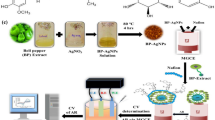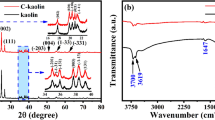Abstract
Arbutin (AR) is one of the important chemical agents that has the lack of adverse effects in cosmetic applications, which has still biological importance and the increasing interest toward arbutin in the cosmetic industry. Electrochemical sensors have received much attention because of their high sensitivity, simplicity, and fast. In this work, an electroanalytical method has been developed and validated for the quantification of AR on nano sepiolite-clay carbon paste electrode. The electrochemical oxidation mechanism of AR was also investigated in the aqueous medium. Nano-sepiolite clay modified carbon paste electrode was used as rapid and the low-level electrochemical sensor for determination of AR. The electrochemical responses of AR were compared on the surfaces of the bare and nano sepiolite modified carbon paste electrode using the cyclic voltammetric method in the BR buffer solution. The results showed the superior electrocatalytic performance on the peak current of AR at the modified carbon electrode. The stripping conditions and experimental parameters (pH, the effect of modifier content, accumulation potential, and time) were optimized to obtain the best oxidation signal of AR. Under the optimized conditions, linear calibration curves were obtained in the concentration range of 0.0362–80.0 µM (with the detection limit of 10.8 nM) with square-wave adsorptive stripping voltammetry. The method was successfully applied for the determination of AR in the cosmetic Tritone cream sample. This work confirms thus that electrochemical sensors may be the potential future candidate for rapid, sensitive, low-level, and reproducible analysis.
Graphic abstract








Similar content being viewed by others
References
Afkhami A, Soltani-Felehgari F, Madrakian T, Ghaedi H (2014) Surface decoration of multi-walled carbon nanotubes modified carbon paste electrode with gold nanoparticles for electro-oxidation and sensitive determination of nitrite. Biosens Bioelectron 51:379–385
Allen JB, Larry RF (2001) Electrochemical methods fundamentals and applications. Wiley
Ardakani MM, Taleat Z, Beitollahi H, Salavati-Niasari M, Mirjalili B, Taghavinia N (2008) Electrocatalytic oxidation and nanomolar determination of guanine at the surface of a molybdenum (VI) complex–TiO2 nanoparticle modified carbon paste electrode. J Electroanal Chem 624:73–78
Aydar S, Bayraktepe DE, Filik H, Yazan Z (2018) A nano˗sepiolite clay electrochemical sensor for the rapid electro-catalytic detection of hydroquinone in cosmetic products. Acta Chim Slov 65:946–954
Bayraktepe DE, Yanardağ T, Yazan Z, Aksüt A (2015) Voltammetric determination of etoposide by using sepiolite clay modified electrode and its interaction with DNA. Rev Roum Chim 60:287–295
Bayraktepe DE, Yazan Z, Polat K (2016) Sensitive and selective voltammetric determination of anti˗cancer agent shikonin on sepiolite clay/TiO2 nanoparticle/MWCNTs composite carbon paste sensor and investigation of its electro˗oxidation mechanism. J Electroanal Chem 780:38–45
Bayraktepe DE, Yazan Z, Önal M (2019) Sensitive and cost effective disposable composite electrode based on graphite, nano-smectite and multiwall carbon nanotubes for the simultaneous trace level detection of ascorbic acid and acetylsalicylic acid in pharmaceuticals. Talanta 203:131–139
Blasco AJ, González MAC, Escarpa A (2004) Electrochemical approach for discriminating and measuring predominant flavonoids and phenolic acids using differential pulse voltammetry: towards an electrochemical index of natural antioxidants. Anal Chim Acta 511:71–81
Bukkitgar SD, Shetti NP, Kulkarni RM, Nandibewoor ST (2015) Electro-sensing base for mefenamic acid on a 5% barium-doped zinc oxide nanoparticle modified electrode and its analytical application. RSC Adv 5(127):104891–104899
Butwong N, Kunawong T, Luong JH (2020) Simultaneous analysis of hydroquinone, arbutin, and ascorbyl glucoside using a nanocomposite of Ag@AgCl nanoparticles, Ag2S nanoparticles, multiwall carbon nanotubes, and chitosan. Nanomaterials 10:1583–1596
Chisvert A, Sisternes J, Balaguer Á, Salvador A (2010) A gas chromatography–mass spectrometric method to determine skin-whitening agents in cosmetic products. Talanta 81:530–536
Christie JH, Turner JA, Osteryoung R (1977) Square wave voltammetry at the dropping mercury electrode: theory. Anal Chem 49:1899–1903
David IG, Popa DE, Calin A-A, Buleandra M, Iorgulescu E-E (2016) Voltammetric determination of famotidine on a disposable pencil graphite electrode. Turk J Chem 40:125–135
Degen GH (2016) Opinion of the Scientific Committee on Consumer safety (SCCS)—opinion on the safety of the use of α-arbutin in cosmetic products. Regul Toxicol Pharmacol 74:75–76
Elyasi M, Khalilzadeh MA, Karimi-Maleh H (2013) High sensitive voltammetric sensor based on Pt/CNTs nanocomposite modified ionic liquid carbon paste electrode for determination of Sudan I in food samples. Food Chem 141(4):4311–4317
Enache TA, Oliveira-Brett AM (2011) Phenol and para-substituted phenols electrochemical oxidation pathways. J Electroanal Chem 655:9–16
Erden S, Yazan Z (2018) A New Sepiolite Clay/TiO2/multiwall carbon nanotube modified carbon paste sensor for the adsorptive stripping square wave voltammetric analysis of vanillin in local food samples. Rev Roum Chim 63:977–986
Gupta VK, Jain R, Radhapyari K, Jadon N, Agarwal S (2011) Voltammetric techniques for the assay of pharmaceuticals—a review. Anal Biochem 408:179–196
Hoyos-Arbeláez J, Vázquez M, Contreras-Calderón J (2017) Electrochemical methods as a tool for determining the antioxidant capacity of food and beverages: a review. Food Chem 221:1371–1381
Huang SC, Lin CC, Huang MC, Wen KC (2004) Simultaneous determination of magnesium ascorbyl phosphate, ascorbyl glucoside, kojic acid, arbutin and hydroquinone in skin whitening cosmetics by HPLC. J Food Drug Anal 12:13–18
Karimi-Maleh H, Karimi F, Rezapour M, Bijad M, Farsi M, Beheshti A, Shahidi SA (2019) Carbon paste modified electrode as powerful sensor approach determination of food contaminants, drug ingredients, and environmental pollutants: a review. Curr Anal Chem 15(4):410–422
Karimi-Maleh H, Karimi F, Alizadeh M, Sanati AL (2020) Electrochemical sensors, a bright future in the fabrication of portable kits in analytical systems. Chem Rec 20(7):682–692
Kim TJ, Park YJ, Park SU, Ha S-H, Kim JK (2018) Determination and quantification of arbutin in plants using stable isotope dilution liquid chromatography–mass spectrometry. Appl Biol Chem 61:523–530
Libánský M, Zima J, Barek J, Dejmková H (2011) Voltammetric determination of arbutin on carbon paste electrode. Sens Electroanal 6:281–287
Lin YH, Yang YH, Wu SM (2007) Experimental design and capillary electrophoresis for simultaneous analysis of arbutin, kojic acid and hydroquinone in cosmetics. J Pharm Biomed Anal 44:279–282
Liu XT, Wang QX, Gao HW (2008) Voltammetric determination of arbutin in cosmetics. Phys Test Chem Anal Part B Chem Anal 44:209–211
Masek A, Zaborski M, Chrzescijanska E (2011) Electrooxidation of flavonoids at platinum electrode studied by cyclic voltammetry. Food Chem 127:699–704
Mehrabi F, Pardakhty A, Ahmadzadeh S (2021) Simultaneous voltammetric determination of ascorbic acid, hydroquinone, kojic acid, and arbutin in pharmaceutical samples; a new approach for quantitative determination of niosomal formulations loading efficiency. Int Pharm Acta 1:135–135
Nady H, El-Rabiei M, Abd El-Hafez G (2017) Electrochemical oxidation behavior of some hazardous phenolic compounds in acidic solution. Egypt J Pet 26:669–678
Ohkatsu Y, Suzuki F (2011) Synergism between phenolic antioxidants in autoxidation. J Jpn Petrol Inst 54:22–29
Parvez S, Kang M, Chung HS, Bae H (2007) Naturally occurring tyrosinase inhibitors: mechanism and applications in skin health, cosmetics and agriculture industries. Phytother Res Int J Devot Pharmacol Toxicol Eval Nat Prod Deriv 21:805–816
Pavitt AS, Bylaska EJ, Tratnyek PG (2017) Oxidation potentials of phenols and anilines: correlation analysis of electrochemical and theoretical values. Environ Sci Process Impacts 19:339–349
Pavlović R, Lakušićć B, Došlov-Kokoruš Z, Kovačević N (2009) Arbutin content and antioxidant activity of some Ericaceae species Die Pharmazie—an international. J Pharm Sci 64:656–659
Pekin M, Bayraktepe DE, Yazan Z (2017) Electrochemical sensor based on a sepiolite clay nanoparticle-based electrochemical sensor for ascorbic acid detection in real-life samples. Ionics 23:3487–3495
Sathisha TV, Swamy BEK, Reddy S, Chandrashekar BN, Eswarappa B (2012) Clay modified carbon paste electrode for the voltammetric detection of dopamine in presence of ascorbic acid. J Mol Liq 172:53–58
Shabani-Nooshabadi M, Roostaee M (2016) Modification of carbon paste electrode with NiO/graphene oxide nanocomposite and ionic liquids for fabrication of high sensitive voltammetric sensor on sulfamethoxazole analysis. J Mol Liq 220:329–333
Shahamirifard SA, Ghaedi M (2019) A new electrochemical sensor for simultaneous determination of arbutin and vitamin C based on hydroxyapatite–ZnO–Pd nanoparticles modified carbon paste electrode. Biosens Bioelectron 141:111474
Shetti NP, Nayak DS, Kuchinad GT, Naik RR (2018) Electrochemical behavior of thiosalicylic acid at γ-Fe2O3 nanoparticles and clay composite carbon electrode. Electrochim Acta 269:204–211
Shih Y, Zen J-M (2000) An electrochemical sensor based on a clay-coated screen-printed electrode for the determination of arbutin. Anal Chim Acta 412:63–68
Švancara I, Vytřas K, Barek J, Zima J (2001) Carbon paste electrodes in modern electroanalysis. Crit Rev Anal Chem 31:311–345
Yazan Z, Erden S, Dinç E (2018) A comparative application of two-way and three-way analysis to three-dimensional voltammetric dataset for the pKa determination of vanillin. J Electroanal Chem 826:133–141
Acknowledgments
The authors are thankful to the Ankara University Research Fund for the financial support. The project numbers are 17H0430009, 15L0430006, and 16L0430002.
Author information
Authors and Affiliations
Corresponding author
Additional information
Publisher's Note
Springer Nature remains neutral with regard to jurisdictional claims in published maps and institutional affiliations.
Supplementary Information
Below is the link to the electronic supplementary material.
Rights and permissions
About this article
Cite this article
Aydar Barutçu, S., Eskiköy Bayraktepe, D., Yazan, Z. et al. Investigation of electrochemical oxidation mechanism, rapid and low-level determination for whitening cosmetic: arbutin in aqueous solution by nano sepiolite clay. Chem. Pap. 75, 3483–3491 (2021). https://doi.org/10.1007/s11696-021-01581-3
Received:
Accepted:
Published:
Issue Date:
DOI: https://doi.org/10.1007/s11696-021-01581-3




